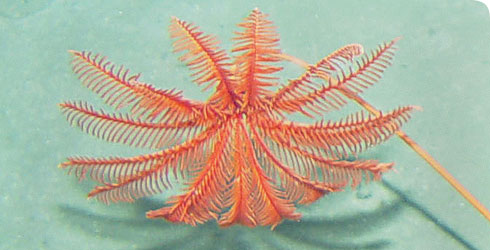Behaviour and ecology
Trophic strategy
- Proisocrinus ruberrimus is a bottom-dwelling filter feeder.
- Crinoids feed mainly on plankton.
Behaviour
The sessile animal is usually fixed to the sea floor by an attachment disk, with its fan-like crown of arms supported by a tether-like stem.
The arms are arranged in a parabolic fan that faces into the prevailing water current and have numerous rows of feather-like pinnules which are covered in podia. The podia are shaped like small tenticles and bear long, slender, mucus-secreting papillae.
During feeding, food:
- becomes trapped in the mucus
- is tossed into the food groove by a sudden whip-like action
- is transported along the food groove to the mouth at the centre of the fan
Migration
Proisocrinus ruberrimus is sessile, limited to bending movements of the stalk and flexion and extension of the arms. Like many other crinoid species it has muscular articulations in the arms that would allow the animal to crawl across the sea bed, but this behaviour has only been observed in other, shallow-dwelling, species.
Associations
These crinoids occur in relatively isolated small colonies on rocky substrates. The high frequency of regenerated arms suggests that they are subjected to frequent non-lethal predation.
Diseases
Due to its rare occurrence, it is not known if Proisocrinus ruberrimus is affected by parasites or disease although many other crinoid species are.
